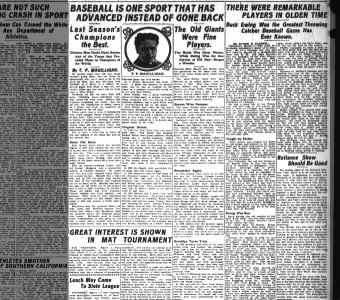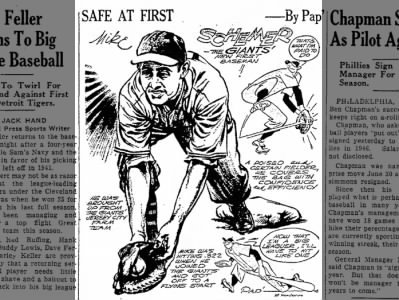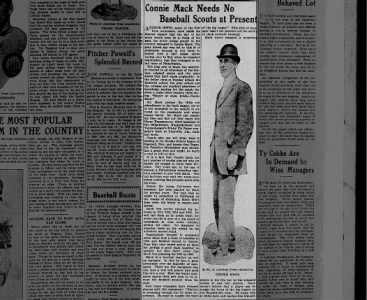In his seminal 1994 book The Politics of Glory, later retitled Whatever Happened to the Hall of Fame?, Bill James memorably predicted 25 years worth of Hall of Fame inductees. It’s fun to go back now and see where James was spot-on and where he absolutely whiffed [Ruben Sierra, anyone?]
In the same spirit, I spent a few hours today coming up with some predictions of my own. The next 20 years of the Hall of Fame ballot, particularly the next decade look like a mess, but I figured someone ought to make sense of it looking forward.
I’ll preface this by saying I made my picks assuming the Veterans Committee will keep its current election structure, having three sub-committees for different eras that rotate with one sub-committee getting to vote each year. I wouldn’t be surprised if this voting structure is tweaked in the next decade, as Veterans Committee processes change often, though I have no idea what the new voting practice will be. I also think the players I suggested have a good shot of going in regardless of when the Veterans Committee allows them to be voted on.
One other thing– I didn’t mess around predicting managers, executives or Negro League selections [though I’d like to see Buck O’Neil and Double Duty Radcliffe enshrined at some point.] That’s for another post.
Anyhow, without further adieu, here is who I see going into the Hall of Fame over the next 20 years:
2015: Pedro Martinez and Randy Johnson in their first year of eligibility with the BBWAA; Craig Biggio in his third year of eligibility
2016: Ken Griffey Jr. in his first year of eligibility with the BBWAA; John Smoltz in his second year of eligibility; Mike Piazza in his fourth year of eligibility; Bill Dahlen through the Veterans Committee
2017: Trevor Hoffman in his second year of eligibility with the BBWAA; Jeff Bagwell in his seventh year of eligibility; Jack Morris through the Veterans Committee
2018: Chipper Jones and Jim Thome in their first year of eligibility with the BBWAA; Minnie Minoso through the Veterans Committee
2019: Mariano Rivera in his first year of eligibility with the BBWAA; Curt Schilling in his seventh year of eligibility; Jack Glasscock through the Veterans Committee
2020: Derek Jeter in his first year of eligibility with the BBWAA; Mike Mussina in his seventh year of eligibility; Alan Trammell through the Veterans Committee
2021: Ichiro Suzuki in his first year of eligibility with the BBWAA; Omar Vizquel in his fourth year of eligibility; Dick Allen through the Veterans Committee
2022: Roy Halladay in his fourth year of eligibility with the BBWAA; Jim McCormick through the Veterans Committee
2023: Todd Helton in his fifth year of eligibility with the BBWAA; Tommy John through the Veterans Committee; a newly-appointed Steroid Era Committee will enshrine strongly-suspected or confirmed PED users whose eligibility with the BBWAA has expired, namely Barry Bonds, Roger Clemens, Rafael Palmeiro, Mark McGwire and Sammy Sosa. It’s lame it might take another decade to begin to resolve the steroid mess on the Cooperstown ballot, but I don’t see it happening sooner. There isn’t huge incentive to take drastic action, for three reasons:
1. This year’s selections of Greg Maddux, Tom Glavine and Frank Thomas showed that top-tier clean candidates can be enshrined their first year of eligibility even with suspected and admitted steroid users clogging the writers ballot.
2. I don’t see the Hall of Fame and Veterans Committee overstepping the authority it’s granted the BBWAA beyond the Hall’s recent move to shorten the window of eligibility for players on the writers ballot from 15 years to 10.
3. It’s not like players stop being eligible altogether for Cooperstown under current voting rules. It’s perfectly logical that the Hall of Fame will allow more time– as much as it deems necessary and then some– for emotions to settle from this period in baseball history before deciding how to honor it.
2024: Vlad Guerrero in his eighth year of eligibility with the BBWAA; Billy Wagner in his ninth year of eligibility; Jim Kaat through the Veterans Committee
2025: Jimmy Rollins in his second year of eligibility with the BBWAA; Andruw Jones in his eighth year of eligibility; Harry Stovey through the Veterans Committee
2026: Albert Pujols in his first year of eligibility with the BBWAA; Tim Raines through the Veterans Committee
2027: Yadier Molina in his first year of eligibility with the BBWAA; Adrian Beltre in his third year of eligibility
2028: Joe Mauer in his third year of eligibility with the BBWAA; Tony Mullane through the Veterans Committee
2029: Miguel Cabrera and Justin Verlander in their first year of eligibility with the BBWAA; Lee Smith through the Veterans Committee
2030: Robinson Cano in his second year of eligibility with the BBWAA; Dustin Pedroia in his third year of eligibility with the BBWAA; Luis Tiant through the Veterans Committee
2031: Jose Reyes and Jered Weaver in their third year of eligibility with the BBWAA; Pete Browning through the Veterans Committee; another meeting of the Steroid Era Committee will enshrine Alex Rodriguez, Manny Ramirez, Gary Sheffield, Andy Pettitte, Ivan Rodriguez and David Ortiz
2032: Andrew McCutchen in his first year of eligibility with the BBWAA; Edgar Martinez through the Veterans Committee
2033: David Wright in his fifth year of eligibility with the BBWAA; Pete Rose, in a sympathy vote from the Veterans Committee shortly after his death
2034: Felix Hernandez in his first year of eligibility with the BBWAA; Paul Goldschmidt in his second year of eligibility
Did I miss anyone? Let me know…
Will get in sometime after 2034, but not too long: Giancarlo Stanton, Mike Trout, Clayton Kershaw, Craig Kimbrel
Wouldn’t mind seeing these guys go in, but it seems unlikely in this timeframe: Carlos Beltran, Ken Boyer, Will Clark, Jim Edmonds, Dwight Evans, Bobby Grich, Keith Hernandez, Gil Hodges, Tim Hudson, Jeff Kent, Kenny Lofton, Evan Longoria, Dale Murphy, Graig Nettles, Tony Oliva, Dave Parker, Scott Rolen, Bret Saberhagen, Johan Santana, Ted Simmons, Cecil Travis, Chase Utley, Larry Walker, Smoky Joe Wood


